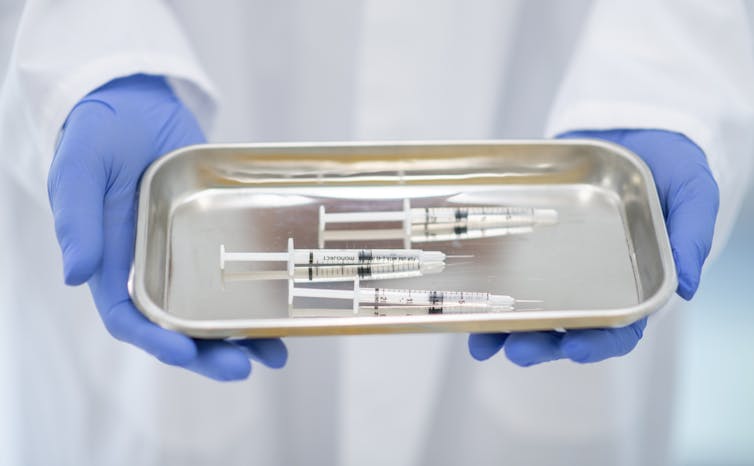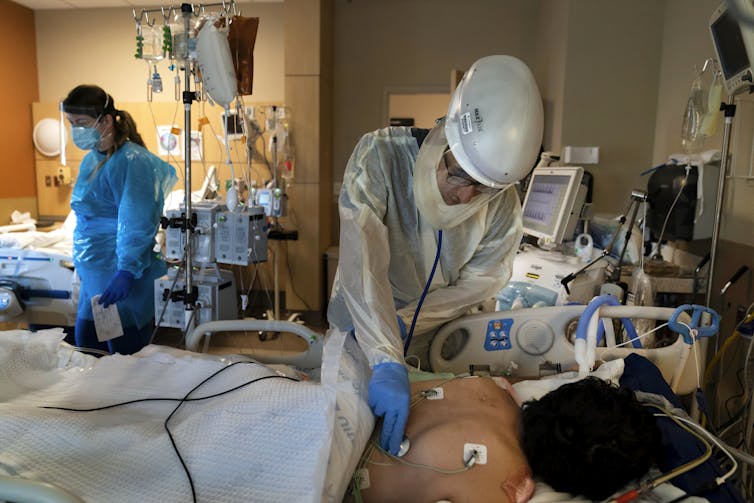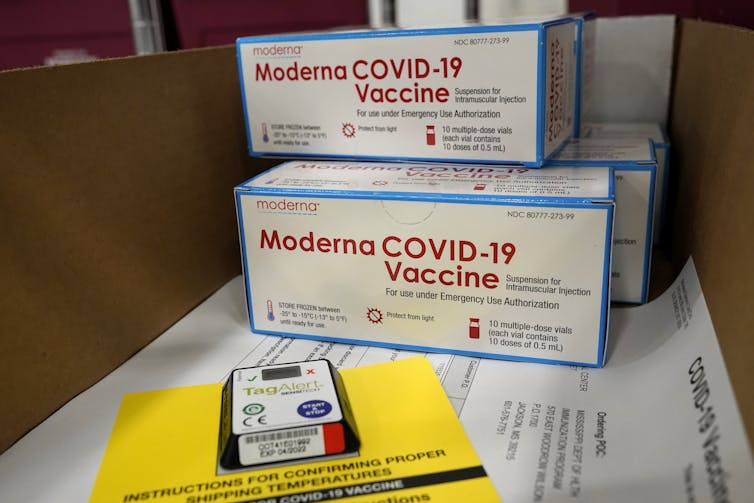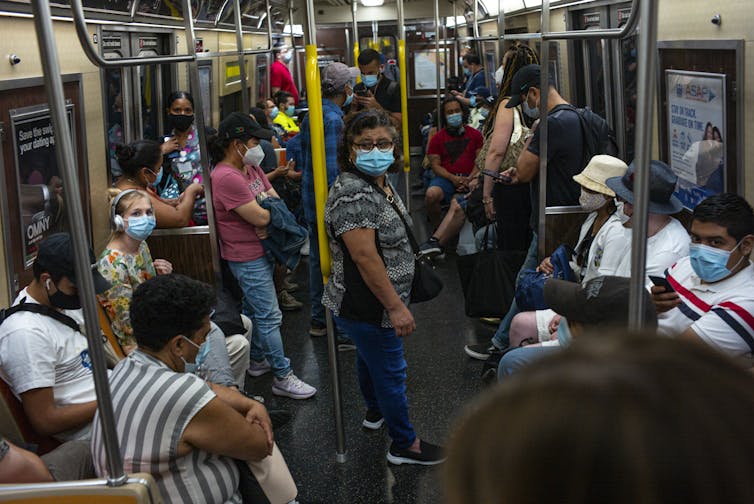Two articles look at the gap between the vaxxed and the unvaxxed. One looks at demographics, the other uses polling data
PART ONE: US is split between the vaccinated and unvaccinated – and deaths and hospitalizations reflect this divide
 |
| As coronavirus cases surge, unvaccinated people are accounting for nearly all hospitalizations and deaths. Fat Camera/E+ via Getty Images |
We are two researchers who work in public health and study immunity, viruses and other microbes.
Since the start of the pandemic, public health experts have been concerned about what might happen if large sections of the U.S. population, for whatever reason, did not get vaccinated.
Over the past few weeks, the answer to that question is starting to emerge.
‘Two Americas’ of vaccination
As of mid-July 2021, the U.S. has fully vaccinated more than 160 million people – just under 50% of the population – against COVID-19. Despite a surplus of available vaccines, in recent weeks the rate of vaccination has slowed substantially. In early April, health workers administered roughly 4 million new vaccines daily. Today, that number is about 450,000 doses a day.
As people sought vaccines over the past few months, the U.S. has split into what Dr. Anthony Fauci, director of the National Institute of Allergy and Infectious Diseases, is calling “two Americas” – one of the vaccinated population and one of the unvaccinated population. These two Americas are divided geographically and in most cases along political lines.
Vaccination rates will continue to rise, albeit slowly, as rural areas get better access to vaccines and messaging persuades some vaccine-hesitant people to get the shot. But according to survey data from late June and early July, more than 10% of adults 18 or older say they are probably not or definitely not going to get a coronavirus vaccine, with another 5% saying they are unsure. It seems likely there will be a large unvaccinated population for the time being.
 |
| In recent months, nearly every hospitalization or death from COVID-19 has been of an unvaccinated person. AP Photo/Jae C. Hong |
Which America is safer?
The vaccines themselves are nothing short of remarkable in their effectiveness at protecting against COVID-19.
Unvaccinated people, by comparison, are extremely susceptible to the coronavirus, particularly to the delta variant and the data on deaths and hospitalizations show this discrepancy clearly.
On July 16, 2021, Centers for Disease Control and Prevention Director Dr. Rochelle Walensky revealed that 99.5% of recent U.S. deaths from COVID-19 were of unvaccinated people. “Those deaths were preventable with a simple, safe shot,” she said.
In Early July, Fauci said that 99.2% of people who died recently were unvaccinated. In the state of Maryland, every patient who died from COVID-19 in June was unvaccinated.
In her July 16 statement, Walensky also said that 97% of current COVID-19 hospitalizations are of unvaccinated people. An earlier analysis done by The Associated Press found that 98.9% of all hospitalized COVID-19 patients in May were unvaccinated. The director of the Los Angeles County Department of Health Services recently stated that all new hospitalized COVID-19 patients in Los Angeles were unvaccinated.
 |
| In most places across the U.S., vaccines are readily available for anyone who wants one. AP Photo/Paul Sancya |
It is hard to find data about overall cases among unvaccinated compared with vaccinated individuals.
This results partly from the CDC’s transition in May 2021 to focusing on hospitalizations of COVID-19 vaccine recipients rather than cases. But one way to get at this data is to compare two states with large differences in vaccination rates.
As the delta variant of SARS-CoV-2 surges across the U.S., one can observe the consequences of this split into a vaccinated and unvaccinated America in real time.
In the state of Missouri, only 40% of people are vaccinated. In some counties within Missouri, as few as 14.7% of the residents are vaccinated. Not surprisingly, the state has seen a surge in COVID-19 cases through the middle of July, with 2,000 to 3,000 new cases per day. The rate of spread is also increasing. Already, some hospitals are running out of ventilators and intensive care beds.
Contrast this with Massachusetts, where 63% of people are fully vaccinated. Though the state is also seeing an increase in cases, total new infections numbered only around 200 to 300 per day. The number of patients hospitalized with COVID-19 in Massachussetts is also down 95% since January 2021.
As of July 20, 2021, Missouri had 1,357 patients hospitalized with COVID-19, almost 13 times more than the 106 patients in Massachusetts. This is despite Missouri’s having a slightly smaller population that is much more dispersed.
Does it matter if people stay unvaccinated?
Ultimately, with a large portion of the U.S. population still unvaccinated, COVID-19 is not going to disappear in the near future. The U.S. will continue to see outbreaks of the virus in communities with low vaccine uptake. Even if people in these under-vaccinated areas rush to get shots when outbreaks happen, it takes about a month for vaccination to produce strong immunity.
As long as SARS-CoV-2 is circulating in the U.S., unvaccinated people will continue to experience the full, dangerous clinical effects of COVID–19. But in addition, while the virus spreads among the unvaccinated, it will also continue spreading at a low level to vaccinated individuals.
Though most of those infections will not progress to severe COVID-19, according to the CDC, as of mid-July more than 5,000 vaccinated people, mostly over 65 years old, had been hospitalized and 1,000 had died. These numbers are of course sad, but they pale in comparison to hospitalizations and deaths among the unvaccinated population.
The vaccines are doing exactly what they were designed to do: prevent severe COVID-19 with amazing efficiency. With vaccines free and widely available, for most people in the U.S. it is a choice: Do you want to be part of the unvaccinated America or the vaccinated one?![]()
Rodney E. Rohde, Professor of Clinical Laboratory Science, Texas State University and Ryan McNamara, Research Associate of Microbiology and Immunology, University of North Carolina at Chapel Hill
This article is republished from The Conversation under a Creative Commons license. Read the original article.
PART TWO: Our analysis of 7 months of polling data shows friendships, the economy and firsthand experience shaped and reshaped views on COVID-19 risks
Wanyun Shao, University of Alabama and Feng Hao, University of South Florida
Even though Americans shared the experience of living through a global pandemic, their individual attitudes towards it differed and evolved – sometimes dramatically.
We study risk perception. Using public opinion polls and state-level data, we conducted an in-depth analysis of how American attitudes and behaviors changed over the course of the pandemic.
Since the first confirmed COVID-19 case in the U.S., over 33 million Americans have been diagnosed with SARS-CoV-2 and more than 600,000 have died. We set out to see how attitudes and beliefs correlated with Americans’ risk perceptions, mask wearing and support for other COVID-19 mitigation measures.
Here’s what we discovered.
Public health and politics are intertwined
Using statistical modeling, we dug into data from public opinion polls conducted by Pew Research Center, National Opinion Research Center, Democracy Fund and UCLA – as well as our own survey combined with state-level data from the Centers for Disease Control and Prevention and Moody’s Analytics and National Conference of State Legislatures.
In a presidential election year characterized by intensifying polarization, public health got caught up in politics.
In March 2020, with uncertainty surrounding COVID-19, contrasting cues from political leaders undoubtedly played a crucial role in shaping risk perception of the virus.
Conservatives who had more confidence in President Trump and his team’s handling of COVID-19, perceived less risk from the virus compared to conservatives with less confidence in Trump.
 |
| Political leaders shaped risk perception. Chip Somodevilla via Getty Images News |
Symmetrically, Democrats who were in favor of then candidate Joe Biden were more supportive of mitigation measures, compared to Democrats who were less supportive of Biden.
By May 2020, national political influence began to be mirrored at the state level. Americans who lived in states with both Democratic governors and legislatures were more likely to perceive COVID-19 as a threat and adjust their behaviors and support policy measures to mitigate transmission of the virus.
Connected communities more likely to slow the spread
When the pandemic was rapidly spreading in early summer of 2020, the CDC recommended wearing masks. Americans with more extensive social connections and stronger trust in others were more likely to engage in mitigation behaviors such as mask wearing.
Individual behavior is influenced by one’s community – such as family, friends and neighbors. As information on the pandemic spread, counties where residents had stronger and closer connections with others started to show a slower increase in COVID-19 cases, as people adopted more infection mitigation measures.
 |
| People in areas with greater social connection were more likely to change their behaviors. Robert Nickelsberg via Getty Images News |
Also, people with stronger and closer connections with others were more likely to act for the common good with the expectation that others would do the same.
Trust promoted social coordination, which provided incentive for people to take similar actions such as wearing masks in response to COVID–19.
COVID-19 survivors less likely to support distancing
In summer 2020, when COVID-19 continued to infect thousands of Americans a day, the CDC recommended mitigation measures such as canceling gatherings, closing schools and restricting non-essential travel.
Americans who contracted COVID-19 – or whose family members had been sick with the coronavirus – didn’t necessarily support mitigation measures after their illness. Perhaps acquiring some measure of immunity by surviving COVID-19 lessened their perceived threat. As philosopher Friedrich Nietzsche once said, “What does not kill me makes me stronger.”
Interestingly, Americans who had coworkers and others in their social circle get COVID-19 were more likely than others to support mitigation measures. It may be those with indirect experience became more anxious about contracting the virus themselves by hearing “horror stories” from others.
Economic recovery falsely signaled safety
In late August to early September 2020, Americans from states whose economies had recovered close to pre-pandemic levels became less concerned about the pandemic and were more likely to forgo mitigation behaviors. We suspect economic recovery provided people with the impression that a return to normal was around the corner, which helped form a false sense of safety.
Risk mitigation closely linked to cases and deaths
COVID-19 case numbers and death rates influenced whether or not people adopted risk mitigation behaviors. Generally speaking, more cases and deaths influenced people to see the virus as a more urgent threat, which resulted in active mitigation behaviors.
Meanwhile, in places with a low number of confirmed cases or deaths, residents were likely to perceive the risk as abstract and distant. Consequently, their motivation to control the transmission of the virus was weak.
Overall, our research shows the combination of timely information with trusting, well-connected communities, is most likely to result in collective risk mitigation behavior. Perhaps these insights can help the U.S. prepare better for the next pandemic.
[Research into coronavirus and other news from science Subscribe to The Conversation’s new science newsletter.]![]()
Wanyun Shao, Assistant Professor of Geography, University of Alabama and Feng Hao, Assistant Professor of Sociology, University of South Florida
This article is republished from The Conversation under a Creative Commons license. Read the original article.